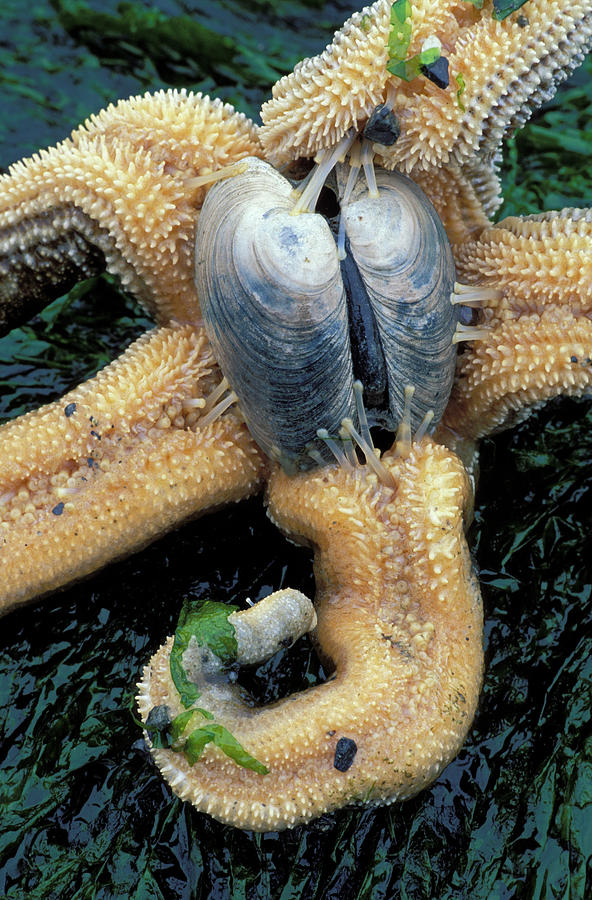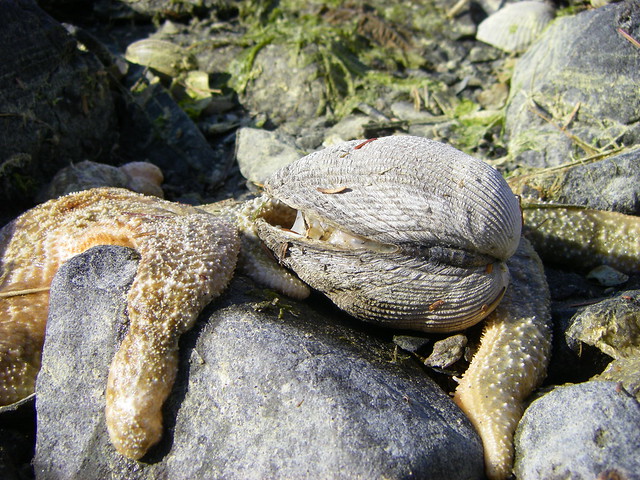Starfish Eating A Clam
Have you ever seen a starfish eating a clam? If not, you're in for a treat. It's a fascinating natural phenomenon that showcases the unique way that starfish capture and consume their prey. Read on to learn more about starfish eating a clam and the intricacies of this process.
The Pain Points of Starfish Eating a Clam
At first glance, watching a starfish eat a clam might seem like a peaceful interaction in the natural world. However, upon closer inspection, there are a few pain points to consider. For example, the clam is fully aware of the starfish's presence and the impending doom that it brings. The starfish moves slowly and deliberately towards its prey, which can be a harrowing experience for the clam. Additionally, once the starfish starts to digest the clam, the process can take hours or even days, leaving the clam in a state of discomfort during that time.
The Target of Starfish Eating a Clam
The target of starfish eating a clam is simple: survival. Starfish need to eat to survive, and clams are a readily available food source for them. Their unique arms have suction cups that allow them to hold onto the clam while they work to pry it open and consume the fleshy inside. The process may be uncomfortable for the clam, but it's essential for the starfish's survival.
The Main Points of Starfish Eating a Clam
Starfish have a unique way of capturing and consuming their prey, including clams. While the process may seem peaceful on the surface, there are pain points to consider for the clam. However, the target for the starfish is simple: survival. Their suction cup arms allow them to hold onto the clam while they pry it open and consume the fleshy inside.
Personal Experience: My Encounter with a Starfish Eating a Clam
During a trip to the beach last summer, I stumbled upon a starfish eating a clam for the first time. It was both fascinating and slightly disturbing to watch. The starfish moved slowly towards the clam, and it seemed like the clam knew what was happening. I watched as the starfish used its suction cup arms to hold onto the clam while it worked to pry it open. The process took a few minutes, and it was clear that the clam was in some degree of distress. While it wasn't the peaceful interaction I had initially thought it would be, it was a fascinating glimpse into the natural world.

Starfish Eating a Clam: Survival of the Fittest
When we think of survival of the fittest, we often picture lions hunting gazelles or wolves chasing deer. However, the concept applies to even the smallest creatures in the natural world, including starfish eating clams. Despite the pain points involved, this process is essential for the starfish's survival. Without food, they wouldn't be able to thrive in the ocean ecosystem.

The Process of Starfish Eating a Clam
When a starfish comes across a clam, it uses its suction cup arms to hold onto it while it works to pry it open. Once the clam is open, the starfish uses its stomach to digest the fleshy inside, which can take hours or even days. This process can be uncomfortable for the clam, but it's a vital part of the natural world.

The Role of Starfish Eating Clams in the Ecosystem
Starfish eating clams plays a vital role in the ocean ecosystem. By consuming clams, starfish help regulate their population and prevent them from overcrowding certain areas. This, in turn, helps maintain a balanced ecosystem where every creature has a role to play.

Questions and Answers
Q: Do starfish only eat clams?
A: No, starfish have a varied diet that can include clams, mussels, snails, and other small invertebrates.
Q: Can a starfish regrow its arms if they're damaged during the clam-eating process?
A: Yes, starfish have the incredible ability to regrow lost arms. This is a survival mechanism that allows them to rebuild if they encounter a predator or suffer some other injury.
Q: How long does it take for a starfish to digest a clam?
A: The digestion process can take anywhere from a few hours to a few days, depending on the size of the clam and the size of the starfish.
Q: Are starfish dangerous to humans?
A: Some species of starfish have small spines that can cause minor irritation if touched, but they're generally considered harmless to humans.
Conclusion of Starfish Eating a Clam
While watching a starfish eat a clam may not be the most peaceful sight, it's a fascinating example of the natural world in action. Through their unique suction cup arms, starfish can hold onto a clam while they work to pry it open and consume the fleshy inside. Despite the pain points involved, this process is essential for their survival, and it plays a crucial role in maintaining a balanced ocean ecosystem.
Gallery
Starfish Eating A Clam | Photo

Photo Credit by: bing.com / starfish eating clam
Dominique And I Found A Starfish Eating A Clam On | Skiff Life

Photo Credit by: bing.com / starfish clam sand interactions
Starfish Eating Clam Photograph By Kevin Adams | Fine Art America

Photo Credit by: bing.com / starfish clam kevin gossipz
Starfish Eating A Clam | Flickr - Photo Sharing!

Photo Credit by: bing.com / clam eating starfish
Star Fish Eating Clam - YouTube

Photo Credit by: bing.com / eating clam star fish